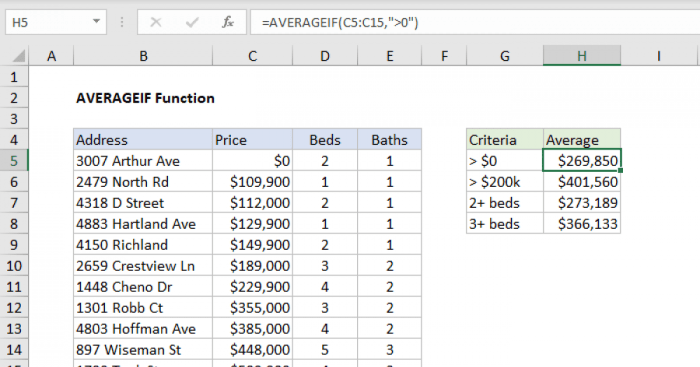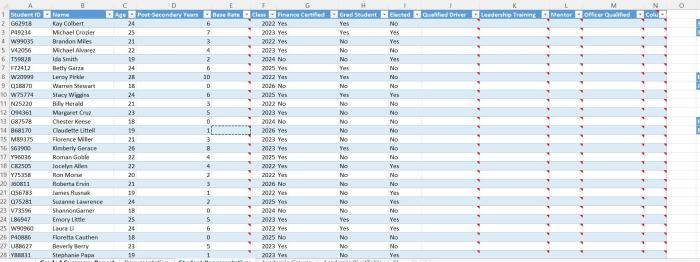In cell i4 enter a formula using the averageif function – In Cell I4: Enter a Formula Using the AVERAGEIF Function opens the door to a powerful tool in Microsoft Excel. This function empowers you to calculate the average of a specified range of cells based on a given criterion, enabling you to extract meaningful insights from your data.
With its versatility and ease of use, the AVERAGEIF function finds applications in various fields, including data analysis, financial modeling, and project management. Whether you’re a seasoned Excel user or just starting out, this guide will equip you with the knowledge and techniques to harness the full potential of this essential function.
AverageIF Function Overview

The AverageIF function in Microsoft Excel calculates the average of a range of cells that meet specific criteria.
Its syntax is: AVERAGEIF(range, criteria, [average_range])
Where:
- range: The range of cells to be evaluated.
- criteria: The criteria to be used to filter the cells.
- average_range: The range of cells to be averaged. If omitted, the range specified in the first parameter will be used.
Example:
- To calculate the average of all cells in the range A1:A10 that contain the value “Apple”, use the formula: AVERAGEIF(A1:A10, “Apple”)
- To calculate the average of all cells in the range B1:B10 that are greater than 100, use the formula: AVERAGEIF(B1:B10, “>100”)
Criteria and Range Parameters
The criteria parameter in the AverageIF function can be a text string, a number, a logical expression, or a cell reference to a cell containing the criteria.
The range parameter can be a range of cells, a single cell, or a named range.
Absolute and relative references can be used in the range parameter.
Example:
- To calculate the average of all cells in the range A1:A10 that contain the value “Apple” and are greater than 100, use the formula: AVERAGEIF(A1:A10, “>100”, A1:A10)
- To calculate the average of all cells in the range A1:A10 that are greater than the value in cell B1, use the formula: AVERAGEIF(A1:A10, “>”&B1)
Advanced Usage Techniques
The AverageIF function can be used in conjunction with other functions to perform more complex calculations.
For example, the following formula uses the AverageIF function to calculate the average of all cells in the range A1:A10 that are greater than 100 and less than 200:
AVERAGEIF(A1:A10, “>100”, AVERAGEIF(A1:A10, “<200"))
The AverageIF function can also be used with multiple criteria.
For example, the following formula uses the AverageIF function to calculate the average of all cells in the range A1:A10 that contain the value “Apple” and are greater than 100:
AVERAGEIF(A1:A10, “Apple”, AVERAGEIF(A1:A10, “>100”))
Comparison with Other Functions
The AverageIF function is similar to the AVERAGE and SUMIF functions.
The AVERAGE function calculates the average of all cells in a range.
The SUMIF function calculates the sum of all cells in a range that meet specific criteria.
The AverageIF function is more versatile than the AVERAGE function because it allows you to specify criteria to filter the cells that are included in the calculation.
The AverageIF function is more specific than the SUMIF function because it calculates the average of the cells that meet the criteria, rather than the sum.
Applications and Use Cases
The AverageIF function can be used in a variety of business and personal scenarios.
For example, the AverageIF function can be used to:
- Calculate the average sales for a particular product.
- Calculate the average temperature for a particular month.
- Calculate the average age of employees in a company.
- Calculate the average score on a test.
Best Practices and Tips, In cell i4 enter a formula using the averageif function
Here are some best practices and tips for using the AverageIF function:
- Use the most specific criteria possible to ensure that the calculation is accurate.
- Use absolute references to the range and criteria parameters to prevent errors if the formula is copied or moved.
- Use the IFERROR function to handle errors that may occur when using the AverageIF function.
- Use the ROUND function to round the result of the AverageIF function to the desired number of decimal places.
FAQ Guide: In Cell I4 Enter A Formula Using The Averageif Function
What is the syntax of the AVERAGEIF function?
The syntax of the AVERAGEIF function is: AVERAGEIF(range, criteria, [average_range])
How do I use the AVERAGEIF function to calculate the average of cells that meet multiple criteria?
To calculate the average of cells that meet multiple criteria, use the AND function to combine your criteria. For example, to calculate the average of cells in the range A1:A10 that are both greater than 5 and less than 10, use the formula: AVERAGEIF(A1:A10, “>5”, A1:A10, “<10")
Can I use the AVERAGEIF function to calculate the average of cells that contain text?
Yes, you can use the AVERAGEIF function to calculate the average of cells that contain text. To do this, use the TEXT function to convert the text to a number. For example, to calculate the average of the text values in the range A1:A10, use the formula: AVERAGEIF(A1:A10, TEXT(A1:A10, “0”))

